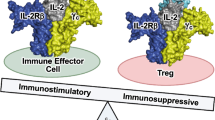Abstract
Systemic cytokine inhibition may be an effective therapeutic strategy for several autoimmune diseases. However, recent studies suggest that tissue or cell type–specific targeting of certain cytokines, including TNF, may have distinct advantages and show fewer side effects. Here we describe protocols for generating and testing bispecific cytokine inhibitors using variable domain of single-chain antibodies from Camelidae (VHH) with a focus on cell-specific TNF inhibitors.
Access this chapter
Tax calculation will be finalised at checkout
Purchases are for personal use only
Similar content being viewed by others
References
Drutskaya MS, Efimov GA, Kruglov AA, Nedospasov SA (2017) Can we design a better anti-cytokine therapy? J Leukoc Biol 102:783–790
Fernandez-Ruiz M, Aguado JM (2018) Risk of infection associated with anti-TNF-alpha therapy. Expert Rev Anti-Infect Ther 16:939–956
Allie N, Grivennikov SI, Keeton R et al (2013) Prominent role for T cell-derived tumour necrosis factor for sustained control of Mycobacterium tuberculosis infection. Sci Rep 3:1809
Kroetsch JT, Levy AS, Zhang H et al (2017) Constitutive smooth muscle tumour necrosis factor regulates microvascular myogenic responsiveness and systemic blood pressure. Nat Commun 8:14805
Grivennikov SI, Tumanov AV, Liepinsh DJ et al (2005) Distinct and nonredundant in vivo functions of TNF produced by T cells and macrophages/neutrophils: protective and deleterious effects. Immunity 22:93–104
Kruglov AA, Lampropoulou V, Fillatreau S, Nedospasov SA (2011) Pathogenic and protective functions of TNF in neuroinflammation are defined by its expression in T lymphocytes and myeloid cells. J Immunol 187:5660–5670
Tumanov AV, Grivennikov SI, Kruglov AA et al (2010) Cellular source and molecular form of TNF specify its distinct functions in organization of secondary lymphoid organs. Blood 116:3456–3464
Kruglov A, Drutskaya M, Schlienz D et al (2020) Contrasting contributions of TNF from distinct cellular sources in arthritis. Ann Rheum Dis. Published Online First: 12 August 2020. https://doi.org/10.1136/annrheumdis-2019-216068
Efimov GA, Kruglov AA, Khlopchatnikova ZV et al (2016) Cell-type–restricted anti-cytokine therapy: TNF inhibition from one pathogenic source. Proc Natl Acad Sci 113:3006–3011
Rashidian M, Keliher EJ, Bilate AM et al (2015) Noninvasive imaging of immune responses. Proc Natl Acad Sci 112:6146–6151
Nosenko MA, Atretkhany K-SN, Mokhonov VV et al (2017) VHH-based bispecific antibodies targeting cytokine production. Front Immunol 8:1073
Nosenko MA, Atretkhany K-SN, Mokhonov VV et al (2019) Modulation of bioavailability of proinflammatory cytokines produced by myeloid cells. Semin Arthritis Rheum 49:S39–S42
Coppieters K, Dreier T, Silence K et al (2006) Formatted anti-tumor necrosis factor alpha VHH proteins derived from camelids show superior potency and targeting to inflamed joints in a murine model of collagen-induced arthritis. Arthritis Rheum 54:1856–1866
Hamers-Casterman C, Atarhouch T, Muyldermans S et al (1993) Naturally occurring antibodies devoid of light chains. Nature 363:446–448
Arbabi Ghahroudi M, Desmyter A, Wyns L et al (1997) Selection and identification of single domain antibody fragments from camel heavy-chain antibodies. FEBS Lett 414:521–526
Van Der Linden R, De Geus B, Stok W et al (2000) Induction of immune responses and molecular cloning of the heavy chain antibody repertoire of Lama glama. J Immunol Methods 240:185–195
Saerens D, Kinne J, Bosmans E et al (2004) Single domain antibodies derived from dromedary lymph node and peripheral blood lymphocytes sensing conformational variants of prostate-specific antigen. J Biol Chem 279:51965–51972
Alturki NA, Henry KA, MacKenzie CR, Arbabi-Ghahroudi M (2015) Isolation of camelid single-domain antibodies against native proteins using recombinant multivalent peptide ligands. Methods Mol Biol 1348:167–189
Beirnaert E, Desmyter A, Spinelli S et al (2017) Bivalent llama single-domain antibody fragments against tumor necrosis factor have Picomolar potencies due to intramolecular interactions. Front Immunol 8:867
Vasilenko EA, Gorshkova EN, Astrakhantseva IV et al (2020) The structure of myeloid cell-specific TNF inhibitors affects their biological properties. FEBS Lett. Published Online First: 31 August 2020. https://doi.org/10.1002/1873-3468.13913
Olleros ML, Chavez-Galan L, Segueni N et al (2015) Control of mycobacterial infections in mice expressing human tumor necrosis factor (TNF) but not mouse TNF. Infect Immun 83:3612–3623
Atretkhany KSN, Mufazalov IA, Dunst J et al (2018) Intrinsic TNFR2 signaling in T regulatory cells provides protection in CNS autoimmunity. Proc Natl Acad Sci 115:13051–13056
Meier SR, Syvanen S, Hultqvist G et al (2018) Antibody-based in vivo PET imaging detects amyloid-beta reduction in Alzheimer transgenic mice after BACE-1 inhibition. J Nucl Med 59:1885–1891
Acknowledgments
Authors thank Drs. A. Kruglov and G. Efimov for advice and Russian Science Foundation (grant #19-75-30032) for financial support. Sequencing of VHH-encoding constructs was performed using the equipment of EIMB RAS ‘Genome’ center (http://www.eimb.ru/ru1/ckp/ccu_genome_c.php).
Author information
Authors and Affiliations
Editor information
Editors and Affiliations
Rights and permissions
Copyright information
© 2021 Springer Science+Business Media, LLC, part of Springer Nature
About this protocol
Cite this protocol
Nosenko, M.A. et al. (2021). Generation and Evaluation of Bispecific Anti-TNF Antibodies Based on Single-Chain VHH Domains. In: Bayry, J. (eds) The TNF Superfamily. Methods in Molecular Biology, vol 2248. Humana, New York, NY. https://doi.org/10.1007/978-1-0716-1130-2_7
Download citation
DOI: https://doi.org/10.1007/978-1-0716-1130-2_7
Published:
Publisher Name: Humana, New York, NY
Print ISBN: 978-1-0716-1129-6
Online ISBN: 978-1-0716-1130-2
eBook Packages: Springer Protocols




